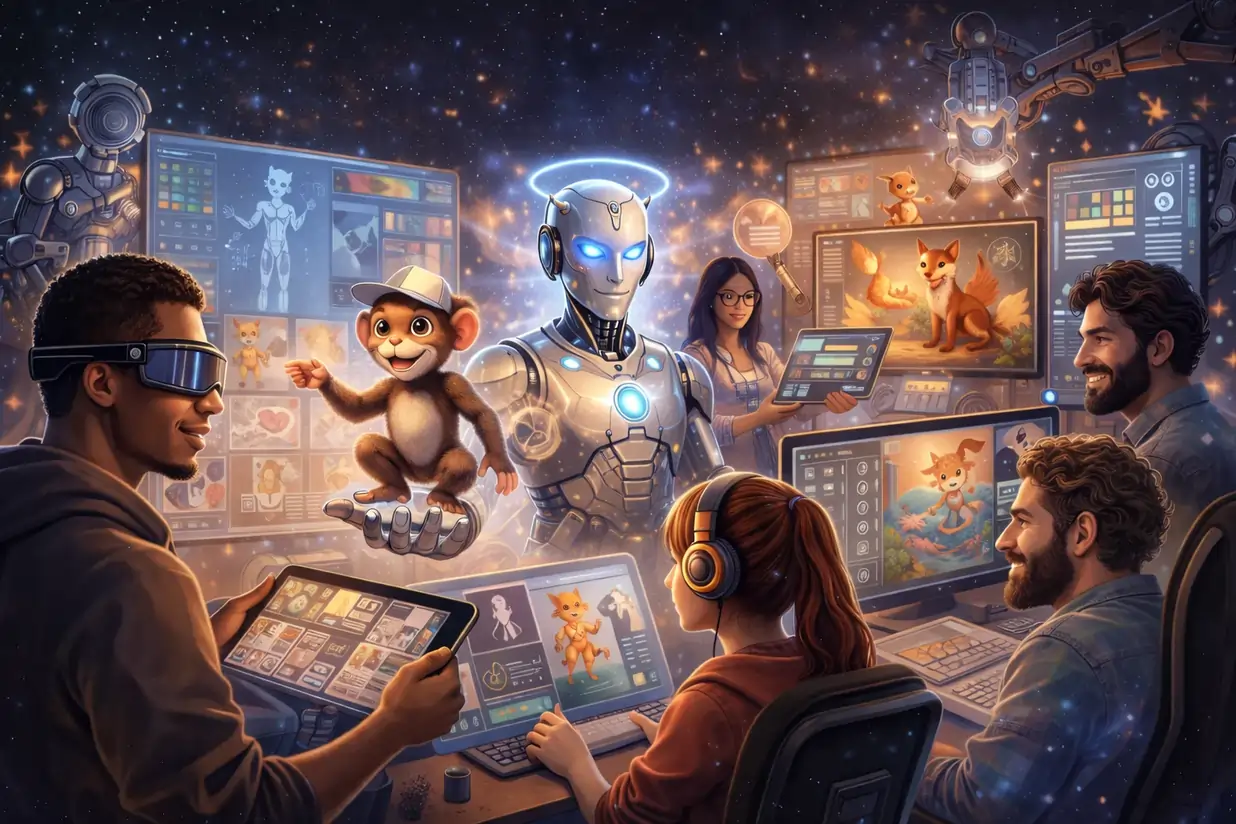The terms “metaverse”, “virtual reality” (VR), and “augmented reality” (AR)” are often used interchangeably, but there are some important differences between them. Metaverse refers to virtual worlds that are created and maintained by their users. It is a persistent, online space where people can interact with each other and with computer generated virtual environment and characters. Virtual reality (VR) is a simulated environment that can be accessed through a VR headset or other device. VR allows users to experience a different world or scenario, which can be either realistic or fantastical. AR overlays digital information in the real world. This can be done using a head-mounted display, smartphone, or tablet. Augmented Reality allows users to see digital content in their physical environment. So, the main difference between AR, VR and metaverse is that metaverse is a user-created online space, virtual reality is a simulated environment, and Augmented Reality overlays digital content in the real world.
What is the Metaverse and How Does it Help in Future World?
Metaverse is a user-created online space where people can interact with each other and with computer-generated characters and objects. It is a persistent, online space that is created and maintained by its users. Metaverse can be used for a variety of purposes, including social interaction, entertainment, education, and business. Metaverse has the potential to revolutionize many industries, including education, healthcare, retail, and more. For example, Metaverse can be used to create virtual reality environments for training or education purposes. Metaverse can also be used to create virtual storefronts for businesses or to create virtual spaces for social interaction. The metaverse has the potential to change the way we live, work, and play. Metaverse can help in the future world by providing a platform for businesses, education, social interaction, and entertainment. Metaverse has the potential to revolutionize many industries and change the way we live, work, and play. Metaverse can help in the future world by providing a Platform as a Service (PaaS) for businesses which is why tech giants like Google, Meta (formerly Facebook) and Tech Mahindra are investing in Metaverse. It can also act as a training ground for new employees or provide a safe environment for product testing. Moreover, Metaverse can be used for social interactions or entertainment purposes. In other words, Metaverse has the potential to change the way we live, work, and play in the future world.

What is the Metaverse in Real Life?
The Metaverse is a user-created online space where people can interact with each other and with computer-generated characters and objects. It is a persistent, online space that is created and maintained by its users. Metaverse can be used for a variety of purposes, including social interaction, entertainment, education, and business.
What are Some of The Challenges That Need To Be Addressed Before Metaverse Can Be Widely Adopted?
One of the challenges that need to be addressed before Metaverse can be widely adopted is data privacy and security. Metaverse is a user-created online space, which means that users create and maintain the Metaverse. This raises concerns about who owns the data that is created in Metaverse and how it will be used. Another challenge that needs to be addressed is scalability. Metaverse is a persistent, online space, which means that it needs to be able to support a large number of users simultaneously.
Some of the Benefits of Metaverse Include:
- The metaverse has the potential to revolutionize many industries, including education, healthcare, retail, and more.
- Metaverse can be used to create virtual reality environments for training or education purposes.
- Metaverse can also be used to create virtual storefronts for businesses or to create virtual spaces for social interaction.
- The metaverse has the potential to change the way we live, work, and play.
- The metaverse can help in the future world by providing a platform for businesses, education, social interaction, and entertainment.
- Metaverse has the potential to revolutionize many industries and change the way we live, work, and play in the future world.
- Metaverse can help in the future world by providing a Platform as a Service (PaaS) for businesses.
- Metaverse can also act as a training ground for new employees or provide a safe environment for product testing.
- Metaverse can be used for social interactions or entertainment purposes. In other words, Metaverse has the potential to change the way we live, work, and play in the future world.
One of the challenges that need to be addressed before Metaverse can be widely adopted is data privacy and security. Metaverse is a user-created online space, which means that users create and maintain the Metaverse.
How Do I Get Into The Metaverse?
There are many ways to get into the metaverse, and the best way for you will depend on your own interests and goals. Here are a few ways to get started:
- Use a virtual environment platform like Second Life or Sansar to create and explore digital environments.
- Play multiplayer online games that offer immersive, 3D realms to explore.
- Use VR headsets like the Oculus Rift or HTC Vive to experience fully immersive VR.
- Create or purchase digital avatars to represent yourself in online spaces.
No matter which method you choose, getting into the metaverse can be a fun and exciting way to explore new ideas and meet new people from all over the world. By helping people socialize in an innovative way, the Metaverse can be considered as the next big evolution in your most used social media platform.
Do We Need VR For Metaverse?
The Metaverse is a proposed future internet meta-layer built on top of existing infrastructure. The word “Metaverse” is a combination of the words “meta” and “universe”, and was first coined by Neal Stephenson in his 1992 science fiction novel Snow Crash. In the book, the Metaverse is a virtual reality platform that allows users to interact with each other and with digital content in a 3D space. Since then, the term has been used to describe a variety of different concepts, ranging from Augmented Reality to virtual environment.
However, the common thread between all these concepts is that they represent a shift away from traditional 2D web platforms like social media towards more immersive 3D experiences.
There are many potential applications for the Metaverse, ranging from social media to gaming to education and training.However, one of the most promising applications is in the area of online commerce. In traditional e-commerce platforms like Amazon or eBay, buyers and sellers are limited to interacting with each other through text or 2D images. This can make it difficult to gauge the quality of a product or to negotiate a fair price.

There is no one answer to this question, as there is no one way to access the metaverse. Some people may connect to the metaverse through virtual reality devices, while others may use Augmented Reality mixed reality technologies. Some people may even create their own Metaverse experiences using game engines or other software tools. The important thing is that there is no single way to get into the Metaverse – it is whatever you make of it. So, if you’re interested in exploring the Metaverse, the best way to start is by finding a community or platform that resonates with you and your interests. From there, you can begin to create your own Metaverse experiences or explore ones created by others. Who knows – you may even find yourself at the forefront of Metaverse development someday!
What is Virtual Reality and How Does it Differ From Metaverse
Virtual reality technology (VR) is a simulated experience that can be accessed using a computer. VR simulations typically provide users with an immersive environment in which they can interact with objects and other people. Metaverse, on the other hand, is a term used to describe the virtual environment created by the convergence of the Internet, artificial intelligence, and virtual reality. Metaverse is often described as a ” Meta-Internet” or “3D Internet” due to its ability to connect users from all over the world in a three-dimensional space. While both Metaverse and virtual reality offer users a simulated experience, there are some key differences between the two. Metaverse is designed to be a more social platform, where users can interact with each other in a three-dimensional space. Metaverse also can connect users from all over the world, whereas virtual reality is typically limited to a single user or small group of users. Finally, Metaverse is still in development and is not yet widely available, while virtual reality is already being used in several industries.
What is Augmented Reality (AR) and How Does it Different From Metaverse and Virtual Reality?
AR technology (Augmented Reality Technology) and AR glasses allows users to overlay digital information in the real world. Unlike virtual reality, Augmented Reality simulations typically provide users with an immersive environment in which they can interact with objects and other people. Metaverse, on the other hand, is a term used to describe the virtual space created by the convergence of the Internet, artificial intelligence, and virtual reality. Metaverse is often described as a ” Meta-Internet” or “3D Internet” due to its ability to connect users from all over the world in a three-dimensional space. Augmented Reality is being used in many AR apps that can be accessed on your mobile devices. You might be using this form of technology in your day to day life without even realizing it. One such example is the line of filters brought up by Snapchat Inc. which allows you to access AR filters using your camera. You can also try on shoes, bags, clothes and other accessories using AR. in the physical world. Recently, Burberry and Gucci released two iOS apps that work on AR technology to enhance their user interface. In this way, AR is helping eCommerce websites increase their sales using 3D animation. Augmented reality lets you experience virtual objects in the real world environment and therefore lets you encounter a mixed reality stimulation in one go. While both Metaverse and augmented reality offer users a simulated experience, there are some key differences between the two. Metaverse is designed to be a more social platform, where users can interact with each other in a three-dimensional space. Metaverse also can connect users from all over the world, whereas augmented reality is typically limited to a single user or small group of users. Finally, Metaverse is still in development and is not yet widely available, while augmented reality is already being used in several industries.
Conclusion
We’ve looked at what metaverse, virtual reality, and augmented reality are and how they differ. Metaverse is a platform that has the potential to be widely adopted in the future as it helps address some of the challenges facing current virtual reality platforms. It provides users with a more immersive experience while also giving businesses and individuals a new way to interact and conduct transactions. There are still some challenges that need to be addressed before the metaverse can be widely adopted, but we believe it has great potential.

The Metaverse refers to user-created online spaces where people interact with computer-generated environments and characters. Virtual reality (VR) immerses users in simulated environments, while augmented reality (AR) overlays digital information into the real world.
The Metaverse has the potential to revolutionize industries like education, healthcare, and retail by providing immersive virtual experiences for training, social interaction, and commerce.
Data privacy and security are significant concerns, as the Metaverse relies on user-created content. Scalability is another challenge, as the platform needs to support a large number of users simultaneously.
There are various ways to access the Metaverse, including virtual environment platforms like Second Life, multiplayer online games, VR headsets, or creating digital avatars for online spaces.
While virtual reality can enhance the immersive experience of the Metaverse, it’s not a requirement. The Metaverse encompasses various technologies, including augmented reality and virtual environments.






